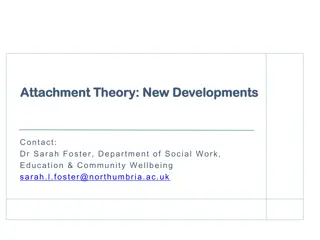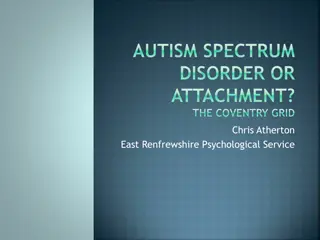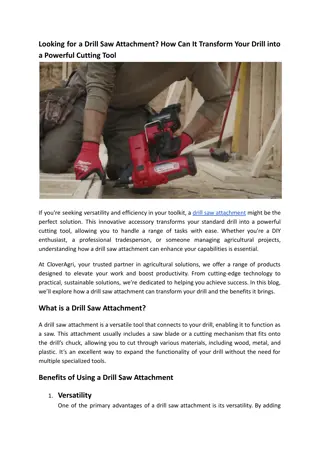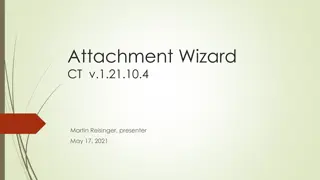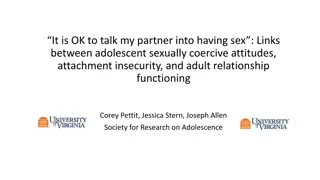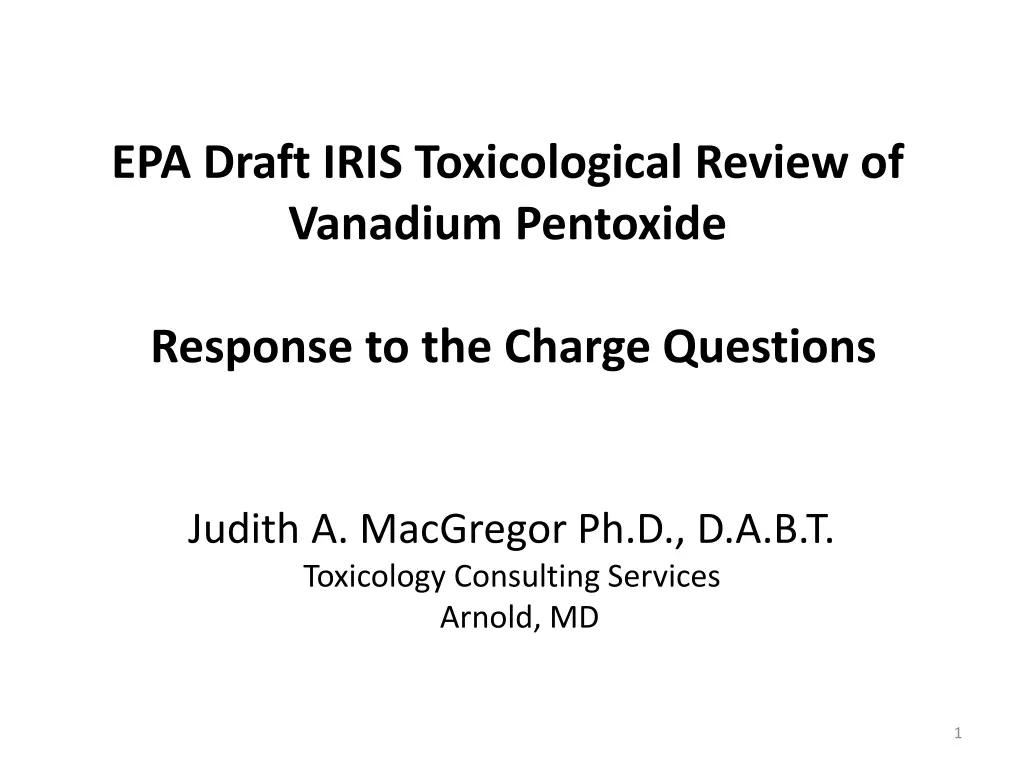
Draft IRIS Toxicological Review of Vanadium Pentoxide - Response and Recommendations
In this review, Judith A. MacGregor, Ph.D., addresses clarity and consistency issues in the draft IRIS Toxicological Review of Vanadium Pentoxide. The document outlines areas for improvement, such as the scope and identification of vanadium compounds, and suggests revisions for better clarity. Recommendations include peer-reviewed studies to be considered and the need for expert input for line-by-line revisions.
Download Presentation

Please find below an Image/Link to download the presentation.
The content on the website is provided AS IS for your information and personal use only. It may not be sold, licensed, or shared on other websites without obtaining consent from the author. If you encounter any issues during the download, it is possible that the publisher has removed the file from their server.
You are allowed to download the files provided on this website for personal or commercial use, subject to the condition that they are used lawfully. All files are the property of their respective owners.
The content on the website is provided AS IS for your information and personal use only. It may not be sold, licensed, or shared on other websites without obtaining consent from the author.
E N D
Presentation Transcript
EPA Draft IRIS Toxicological Review of Vanadium Pentoxide Response to the Charge Questions Judith A. MacGregor Ph.D., D.A.B.T. Toxicology Consulting Services Arnold, MD 1
General Questions: 1. Clear and Concise? + Organization good, format clear, excellent use of bookmarks and links, length of document remove repetition, some of the science missing Scope of the review unclear. Chemical identification inconsistent and contradictory throughout the document 2
Examples of Lack of Clarity and Inconsistencies on the Scope P4: This Toxicological Review focuses exclusively on vanadium pentoxide (V2O5, CASRN 7 1314-62-1) (Figure 2-1), the most common form of vanadium used commercially. vs. P8: 3.1.3 Dermal exposure: Because vanadium is a metal with low solubility, absorption through the skin is thought to be minimal. P8: 3.2. Distribution: The initial section describes vanadium distribution without mention of the pentoxide 3
Examples of Lack of Clarity and Inconsistencies on the Scope Appendix D Supplemental Information D.1. EXPOSURE TO PM2.5 VANADIUM IN AMBIENT AIR This section covers levels of total vanadium compounds and other metals in ambient air D.2. LABORATORY ANIMAL AND IN VITRO STUDIES This section includes toxicological information on studies specifically on vanadium pentoxide, studies of mixtures of vanadium compounds, and studies attributed to vanadium pentoxide where the chemical form of the test material is not likely vanadium pentoxide 4
Recommendations on Scope & Clarity Needs line by line revision throughout with input from vanadium chemistry and toxicology experts Use scientific judgment on whether the test material is in fact vanadium pentoxide or if the study data are relevant to vanadium pentoxide 5
2. Identify additional peer reviewed studies that should be considered There are several useful publications that are not considered or cited and a list will be provided (ex. Duffus, 2007; Schuler et al., 2011; Kiviluoto et al., 1979, 1980, 1981; Zaporowska and Wasilewski, 1989, Fawcett et al. 1996,1997 .) Several studies are cited where the science does not appear to be applied to the derivation of the uncertainty factors (ex. NTP 2002; Kiviluoto et al. 1981) 6
A. Oral Reference Dose, RfD 1. Right study? Yes ( Mountain et al.,) 2. Right critical effect? Yes (Hematology, decrease in RBC) Scientific support could be expanded (NTP, 2002, Zaporowska et al. 1993, etc) 3. NOAEL/LOAEL approach as the POD? Reasonable based on the study design 7
4. RfD: Are the UFs appropriate? Clearly described? Overall uncertainty large = 3000 10-fold uncertainty factor was added for extrapolation from subchronic to chronic effects. A subchronic-to-chronic uncertainty factor, UFS, of 10 was applied for extrapolation from a subchronic to chronic study because a subchronic study was used for the POD. (page 77) Justification lacking in the entire 210 page document 8
Hematological Effects: Time Course Data NTP measured hematological parameters during the 3- month exposure of vanadium pentoxide to F344N rats (2002) Both males and female rats 10 animals per sex per group 5 exposure groups and a control A battery of hematological endpoints measured Measurements repeated on day 4, day 23, week 13 9
RfD: Uncertainty Factor Not Science Based NTP 3-month rat study of vanadium pentoxide Decreases in erythrocytes & hemoglobin (same effects as the Mountain et al. study) Both sexes affected Accommodation apparent by week 13 increases in reticulocytes and/or nucleated erythrocytes/100 WBC in week 13 (NTP, 2002) 10
Accommodation to the hematological effects of inhaled vanadium pentoxide 17 control 4 mg/m3 F344/N male rats 16.5 Hemoglobin (g/dL) 16 ** 15.5 15 14.5 day 4 day 23 week 13 NTP, 2002 11
Accommodation to the hematological effects of NH4VO3 in drinking water 9 8.8 Erythrocytes (1012/dm3) Male Wistar rats 8.6 8.4 * 8.2 8 7.8 7.6 7.4 control 2 wks 4 wks 8 wks Zaporowska and Wasilewski, 1989 12
RfD Uncertainty Factor Subchronic to Chronic Time course data not considered The hematological effects are not increasing after a few months Accommodation apparent The 10 X uncertainty factor for study duration in the derivation of the RfD based on the 3+ month Mountain et al. study not appropriate 13
RfD: 10 X UF for database deficiencies not balanced, reassess A database uncertainty factor, UFD, of 10 was applied to account for database deficiencies due to the lack of a developmental toxicity study and a multigenerational reproductive toxicity study for vanadium pentoxide by the oral route. Studies using alternate routes of exposure (intraperitoneal) have indicated adverse reproductive and developmental effects in response to vanadium pentoxide, including statistically significant increases in seminal vesicle, thymus, and submandibular gland weights in male mice and body weight, thymus, submandibular gland, and liver weights in female mice (Altamirano et al., 1991) as well as reduced fertility (Altamirano-Lozano et al., 1996). EPA draft p77 14
Both studies cited are flawed Test material not vanadium pentoxide (saline solutions) Doses tested in the lethal* range in both studies Intraperitoneal injection not relevant for assessment of developmental effects (especially in mice) Route not appropriate in particular for a reactive material like vanadium pentoxide *Lewis, R.J., Sr. (2000). Sax s Dangerous Properties of Industrial Materials, 10th ed., pp. 3657-3660. John Wiley and Sons, Inc., New York; Altamirano, 1991, 1996. 15
RfD: 10 X UF assessment for database deficiencies- data not considered The NTP 3-month inhalation study included assessment of reproduction system in highest exposure groups in rats and mice (testicular organ weights, histopathology of the testis, epididymis, seminal vesicles, uterus , sperm motility and vaginal cytology) No significant direct effects on these endpoints were noted (NTP, 2002) 16
RfD: 10 X UF assessment for database deficiencies not balanced, reassess The 2- year chronic inhalation study by NTP included assessment of reproduction system large group size (50 animals) both sexes, two species MTD+ level exposures gross and histopathology of all animals (ovary, uterus, prostate gland, testis, epididymis, penis, preputial gland, seminal vesicle No pathological changes in the reproductive system were attributed to treatment (NTP, 2002). In both studies the exposures exceeded the MTD, thus exposures were sufficient for effects to have been detected. (NTP, 2002) No mention of these data in the section on the database deficiencies with respect to reproductive effects 17
Animal to human extrapolation (UF=30X) data not considered Hematological parameters have been measured in human studies on vanadium pentoxide, vanadates and vanadyls and do not show increased sensitivity to humans Studies in humans not mentioned and/or not considered. Kiviluoto et al. 1980, Goldfine et al. 1995, 2000; Dimond et al. 1963; Fawcett et al. 1996, 1997 18
Conclusions RfD 10 fold error in expression of the RfD p77 Key study selection reasonable, key effect appropriate -strengthen the basis, NOAEL as POD appropriate Relevant science not cited or considered in the uncertainty factors Uncertainty factors not science based, reassess 19
B. Inhalation Reference Concentration 1. Right study? (NTP chronic study, 2002) Exposures high, too narrow a dose range, effects appear to be at or close to maximal, study methodological weaknesses not considered, not referenced (Duffus, 2007) 2. Right critical effect? Pulmonary system correct target. Endpoint selected inflammation of the larynx problematic. Reconsider 3. Benchmark dose modeling Problematic based on the marked lung pathology measured in most animals in the chronic NTP inhalation study 20
Datasets for derivation of the RfC Kiviluoto et al. 1979-81 A series of 7 publications on workers in a vanadium pentoxide production facility Comprehensive endpoints evaluated Pulmonary evaluations included chest x-rays, pulmonary function tests, nasal biopsy with cytology Only 4 of the 7 papers cited. Missing the key publication used by the ACGIH in 2009 to derive the TLV for vanadium pentoxide 21
Datasets for derivation of the RfC NTP 3-month inhalation study Unusually robust : 5 exposure groups plus chamber control Concentration ranged 1 to 16 mg/m3 included a range from a NOAEL at the lowest level (1mg/m3) to effects in most animals at the higher concentrations tested Large group size 10 per sex, rats and mice Histopathology of the pulmonary tract 22
B. 4. RfC: 10 fold UF for database deficiencies not balanced, reassess Based on 2 studies with significant limitations and flaws (Altamirano et al., 1991; Altamirano-Lozano et al., 1996) + The 3-month & chronic inhalation studies conducted by the NTP included gross and histopathology of the reproductive system. No pathological changes in the reproductive system were attributed to treatment (NTP, 2002). 23
C. 1 Cancer classification scientifically supported and described clearly? The draft Toxicological Review of Vanadium Pentoxide characterizes vanadium pentoxide as likely to be carcinogenic to humans by the inhalation route of exposure Based on 2 studies (NTP chronic inhalation study and Rondini et al.) Limitation to the inhalation route appropriate Database inconsistencies not acknowledged 24
C. 1 Cancer classification scientifically supported and described clearly? Database inconsistencies not acknowledged + Mouse lung tumors both sexes - Rat lung tumors not statistically significant in either males or females - No evidence of initiation (Rondini, 2011) Promotion seen in 2 strains of mice but not in the 3rd strain (B6) (Rondini, 2011) - No DNA damage in lung or BAL cells (Schuler et al., 2011) 25
Inconsistencies with the EPA 2005 Guidelines for Carcinogen Risk Assessment NTP chronic study limitations should be considered exposure levels high, limited range, marked inflammatory lung pathology, methodology issues Weight of evidence not assessed Consider variable responses among mice vs. rats, and among strains of mice Consider current historical data NTP 2000 diets 26
NTP study lung cancer assessment: then (2001) vs. now (2011) Female rats: Alveolar/bronchiolar adenomas in the low dose group was at or above historical control values (NTP, 2002 p95) 0.5 Ad 0% 6% Adenoma (historical) then: NTP 2000 diet 0- 6%* - (*single study); NIH diet 0-4% now: NTP 2000 diet 0-8%** (**4 studies) mg/m3 0 1 2% 2 0% 27
NTP study lung cancer assessment: then (2001) vs. now (2011) Female rats: Alveolar/bronchiolar carcinoma in the high dose group was at or above historical control values (NTP, 2002 p95) mg/m3 0 0.5 Ca 0% 0% Carcinoma (historical control) then: NTP 2000 diet 0-2%* - (*single study); NIH diet 0-2% now: NTP 2000 diet 0-2%** (**3 studies) 1 0% 2 2% 28
NTP study lung cancer assessment: 2001 vs. 2011 Male rats: Alveolar/bronchiolar carcinoma above historical control values in the 0.5 and 2 mg/m3 group, never more than 1 (2%) in any study (NTP, 2002 p94) mg/m3 0 0.5 Ca 0% 6% Carcinoma (historical control) then: NTP 2000 diet 0-2% now: NTP 2000 diet 0-6% 1 0% 2 6% 29
NTP study lung cancer assessment No evidence of lung tumors in female F344/N rats exposed to 0.5, 1 or 2 mg/m3 vanadium pentoxide EPA IRIS draft cancer assessment inaccuracies: p 40 0.5 mg/m3 statistically significantly different from historical controls p 50 historical data shown for NIH 07 diet p 50 source to 2002 report p 89 evidence at the high dose female rat group equivocal p 93 female rat tumors are increased over spontaneous P94 lung neoplasm incidence was reported in male and female rats P95 The carcinogenic response occurs across genders and species. P97 Long-term exposure (2 years) in F344/N rats and B6C3F1 mice similarly resulted in increased incidence of respiratory toxicity and carcinogenicity (NTP, 2002). P99 & 102 Information available on the carcinogenic effects of vanadium pentoxide via the inhalation route is limited to examination of respiratory tumors. D29 Indeed, the marginal increase in lung neoplasms observed in female rats was not statistically significant. 30
Cancer Classification Inconsistencies with Other Organizations IARC 2006 2B = possibly carcinogenic to humans ACGIH 2009 A3= Confirmed animal carcinogen with unknown relevance for humans Similar database reviewed but different outcomes Database does not support likely human carcinogen 31


